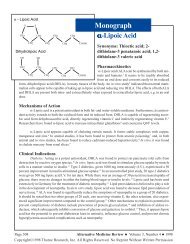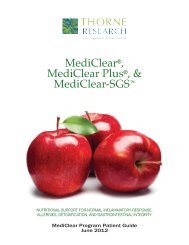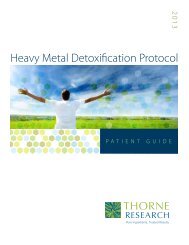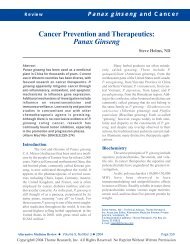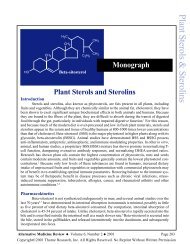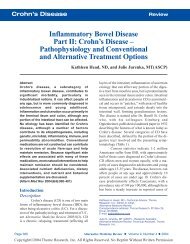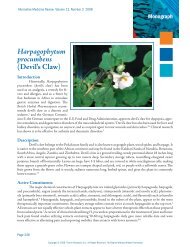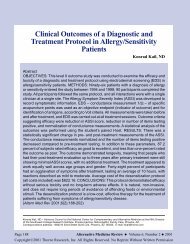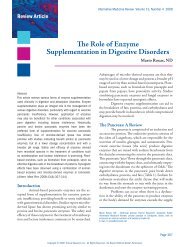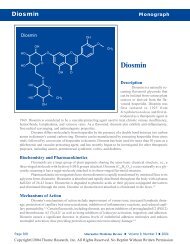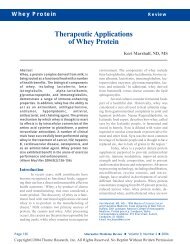St. John's Wort - Thorne Research
St. John's Wort - Thorne Research
St. John's Wort - Thorne Research
Create successful ePaper yourself
Turn your PDF publications into a flip-book with our unique Google optimized e-Paper software.
<strong>St</strong>. John’s <strong>Wort</strong> (Hypericum perforatum):Clinical Effects on Depression and OtherConditions.by Alan L. Miller, N.D.Abstract<strong>St</strong>. John’s <strong>Wort</strong> (Hypericum perforatum), a perennial flowering plant, has beenused medicinally for thousands of years, and has most recently been identified as aneffective treatment for mild to moderate depression. Clinical studies on the use of thisplant for depression have utilized liquid tinctures and standardized solid extracts (0.3%hypericin—300 mg three times a day). Severe depression may also respond to thisbotanical, although it appears a larger dose is needed (600 mg solid extract threetimes a day). Hypericum has been favorably compared to numerous antidepressantdrugs, the studies having revealed equivalent results and a much more favorableincidence of side effects. <strong>St</strong>udies have also demonstrated its efficacy in treating seasonalaffective disorder. In vitro investigations of Hypericum show antiviral activity, althoughthere is evidence these promising results might not occur in vivo. Traditional actionsand uses include enhancement of wound healing, as well as anti-inflammatory andanalgesic activity.(Alt Med Rev 1998;3(1):18-26.)IntroductionHypericum perforatum, also know as <strong>St</strong>. John’s <strong>Wort</strong>, Klamath weed, and goat weed, isa perennial weed which grows in sunny areas in well-drained, sandy soil, and is commonly seengrowing by the roadside and along railroad beds. It is native to Europe and Asia, and wasbrought to the United <strong>St</strong>ates by European colonists. Its small, five-petaled, yellow flowers canturn a field into a sea of amber, a sight which, although beautiful, angers farmers who considerit a noxious weed. Hypericum’s leaves contain tiny translucent excretory glands which looklike perforations (hence, the Latin name) which are easily seen if held up to a bright lightsource. Small dark dots on the flowers contain a reddish-brown pigment, identified as hypericin.The Hypericum genus contains over 370 species; however, H. perforatum is unique in itsappearance and chemical makeup. It is distinguished from other species in its appearance by acylindrical stem with longitudinal, opposing ribs. 1The name <strong>St</strong>. John’s <strong>Wort</strong> comes from the fact it flowers around <strong>St</strong>. John’s Day (June24). It is also said its red pigment symbolizes the blood of <strong>St</strong>. John. The word wort is an OldEnglish term for plant. Hypericum is derived from the Greek words hyper (above) and eikonAlan L. Miller, N.D.—Technical Advisor, <strong>Thorne</strong> <strong>Research</strong>, Inc.; Senior Editor, Alternative Medicine Review.Correspondence address: P.O. Box 25, Dover, ID 83825. alan@thorne.comPage 18 Alternative Medicine Review ◆ Volume 3, Number 1 ◆ 1998Copyright©1998 <strong>Thorne</strong> <strong>Research</strong>, Inc. All Rights Reserved. No Reprint Without Written Permission
Hypericum<strong>St</strong>. John’s <strong>Wort</strong> (Hypericum)(icon or image). AncientGreeks and Romans placedsprigs of Hypericum aboveimages or statues in theirhomes, as they believed thisplant had mystical powersto protect them from evilspirits. 2 In the present day,Hypericum is used primarilyto “ward off” depressiveillness. In ancienttimes, “evil spirits” mayhave referred to just this indication,as depression candescend quietly and withoutany known reason.For centuries Hypericumhas been usedorally and topically, as ananti-inflammatory, sedative,analgesic, diuretic,antimalarial, and as a vulnerary(a substance whichenhances wound healing).Traditional indications have included trauma,burns, rheumatism, hemorrhoids, neuralgia,gastroenteritis, snakebite, ulcers, contusions,sprains, diarrhea, menorrhagia, hysteria,bedwetting, and depression. 1,2 The vast majorityof the clinical research on <strong>St</strong>. John’s <strong>Wort</strong>concerns its impact on depression. Public andpractitioner response to this mostly-Europeanresearch has caused a standardized extract ofthis plant to become the most utilized antidepressanttreatment in Germany. 3 Investigationsinto the antiviral activity of Hypericum mayalso prove to be clinically useful in the future.Depression affects more than 17 millionadults in the United <strong>St</strong>ates each year, costingthe nation $44 billion in treatment, disability,and lost productivity. 4 Cognitivetherapy and other forms of non-pharmacologicaltreatment bring about a resolution of symptomsin many individuals with depression.In addition, pharmacological orphytopharmacologicalmethods are often helpful inreleasing the grip of depression.Efficacy and safety areprime concerns when consideringany therapeuticmodality; however, pharmacologicaltreatment ofdepression often results inunwanted effects of thedrug, frequently resulting innon-compliance or discontinuationof treatment. In arecent comparative study of<strong>St</strong>. John’s <strong>Wort</strong> versus thetricyclic antidepressant amitriptylinein the treatment ofmoderate depression, Hypericumwas found to besimilar in its efficacy to thedrug, with significantlyfewer side-effects. 5 Vorbachet al, found equivalent efficacybetween <strong>St</strong>. John’s<strong>Wort</strong> and imipramine in severely depressed patients.However, <strong>St</strong>. John’s <strong>Wort</strong> patients exhibiteda 0.7% drop-out rate due to adverseeffects, compared to a 7.8% drop-out rate dueto side-effects of imipramine treatment. 6Tricyclic and monoamine oxidase inhibitor(MAOI)-based antidepressants havebeen utilized clinically for more than 40 years.Their major drawbacks are the high frequencyof side-effects and high toxicity. The newerantidepressants, the selective serotoninreuptake inhibitors (SSRIs), are better toleratedand less toxic than the first generationantidepressants, 3 although significant side-effectsare still not unusual. This issue may be asignificant component of Hypericum’s recentpopularity.Hypericum contains numerous compoundswith biological activity (see Table 1).It is not known at this time if one chemical orAlternative Medicine Review ◆ Volume 3, Number 1 ◆ 1998 Page 19Copyright©1998 <strong>Thorne</strong> <strong>Research</strong>, Inc. All Rights Reserved. No Reprint Without Written Permission
Table 1. Identified Chemical Constituents ofHypericum perforatum 7,8,9NaphthodianthroneshypericinpseudohypericincyclopseudohypericinisohypericinprotohypericinFlavonoidshyperosiderutinquercetinquercetrinisoquercetrincampherolluteolinmangiferinProanthocyanidinscatechinepicatechinprocyanidin B2BiflavonesI3,II8-biapigeninamentoflavoneXanthones1,3,6,7-tetrahydroxyxanthonePhloroglucinolshyperforinadhyperforinEssential oilsAmino acid DerivativesGABAmelatoninPhenylpropaneschlorogenic acida combination produces the antidepressant effectsof <strong>St</strong>. John’s <strong>Wort</strong>.Mechanisms of Action in DepressionThe biogenic amine theory of depressionsuggests it is caused by a deficiency ofserotonin or norepinephrine. These neurotransmittersare actively secreted into synapses byneurons, then are taken up by receptors at thepost-synaptic neuron. They are subsequentlyeither stored or catabolized by monoamineoxidase. Therefore, substances having a positiveeffect on depression (drugs orphytomedicinals) should impact the levels ofthese neurotransmitters by: (1) increasing biogenicamine synthesis; (2) decreasing theircatabolism by inhibiting monoamine oxidase;or (3) inhibiting their re-uptake.Early in vitro studies of various componentsof <strong>St</strong>. John’s <strong>Wort</strong> extract led to theestablishment of MAO inhibition asthe possible mechanism forHypericum’s antidepressant effects.10,11 However, more recent investigationin this area suggests that,although MAO inhibition does occurwith high concentrations of Hypericumconstituents, it does not in theamounts found in commercial extracts.12-14Testing by Perovic and Müllerdemonstrate a dose-dependent decreaseof serotonin uptake by rat synaptosomestreated with Hypericumextract. The authors conclude theantidepressant activity of Hypericumextract is due to inhibition of serotoninuptake in post-synaptic receptors.15 In an attempt to elucidate theeffects of Hypericum on serotoninreceptors, Müller and Rossol incubatedrat neuroblastoma cells withHypericum solutions, and observeda decrease in serotonin receptor expressioncompared to a control solution withoutthe extract. The researchers stated the reductionin serotonin receptors results in animpaired reuptake of serotonin, an effect similarto the selective serotonin reuptake inhibitorssuch as Prozac ® . 16Müller et al, observed decreased synaptosomaluptake of serotonin, dopamine andnorepinephrine by Hypericum, as well as weakinhibition of MAO-A and MAO-B activity invitro. In light of this and other research whichhas suggested Hypericum may inhibit thereuptake of these neurotransmitters and enzymes,the authors conclude, “The fact thatHypericum shows affinity for three differentneurotransmitter transporter systems mightpoint to an unique and not yet known mechanismof inhibition of neurotransmitter uptake.”14Page 20 Alternative Medicine Review ◆ Volume 3, Number 1 ◆ 1998Copyright©1998 <strong>Thorne</strong> <strong>Research</strong>, Inc. All Rights Reserved. No Reprint Without Written Permission
HypericumA recent study foundß-adrenoreceptors down-regulated and5-hydroxytryptophan (5-HT 2) receptors upregulatedby Hypericum. 14 ß-adrenoreceptordown-regulation is also seen with treatmentby antidepressant drugs such as the tricyclicimipramine. 5-HT 2receptors are usually downregulatedalso, so the finding of up-regulationby Hypericum extract is atypical.Hypericum extract was also found todecrease binding of a benzodiazepine drug tobenzodiazepine-binding sites on GABA Areceptorsin vitro. Amentoflavone, a biflavoneconstituent of the extract, had the greatest inhibitoryactivity at these receptors. Hypericin,quercetin, rutin, and the biflavone 13,II8-biapigenin did not inhibit binding. 17A Hypericum tincture was recently investigatedto determine if an alcohol/waterextract has the same receptor-inhibiting activityas the standardized solid extracts. It wasobserved that the crude extract has an affinityfor 5HT1, GABA Aand GABA B, benzodiazepine,and both MAO-A and MAO-B receptors,18 which is similar to what has been notedfor standardized solid extracts.Another theory of depression which isgaining acceptance may provide a possibleexplanation for the antidepressant activity of<strong>St</strong>. John’s <strong>Wort</strong>. Inflammatory cytokines, suchas the interleukins and tumor necrosis factor,in addition to their effects on the immunesystem, may act as “messenger molecules” inthe central nervous system. Interleukin(IL)-1and IL-6 are potent activators of thehypothalamic-pituitary-adrenal (HPA) axis viastimulation of corticotropin-releasing hormone(CRH). Suppression of the normal HPA axisdown-regulation is a frequent finding inendogenous depression, 19 and is characterizedby hypersecretion of CRH, hypersensitivity ofthe adrenal cortex to ACTH, and increasedcortisol levels. 20-22 It is hypothesized thatcytokines such as IL-1 and IL-6, since theyseem to be heavily involved in cell-to-cellcommunication both inside the immunesystem and within the nervous system, mayact as neuromodulators involved in depression.Thiele et al reported Hypericum to be apowerful inhibitor of phytohemagglutininstimulatedIL-6 release in an in vitro blood cellculture test. Controls and depressed patientsshowed marked inhibition of IL-6 release withHypericum. 23 If this inhibition of IL-6 occursin vivo, it could partially elucidate amechanism for Hypericum in depression, asIL-6 inhibition might “re-set” the hyperactivehypothalamic-pituitary-adrenal axis.One sequelae of prolonged cortisol increaseis a reduction in serotonin synthesis.Excess cortisol activates the enzyme tryptophanpyrrolase, shunting the dietary aminoacid precursor tryptophan away from the serotoninpathway and into the kynurenine-to-niacinpathway, resulting in inhibited serotoninproduction and reduced sensitivity of serotoninreceptors. 24From these studies, it is noted that Hypericummay have an effect on serotonin,GABA, MAO, dopamine, norepinephrine, ß-adrenoreceptors, interleukins, and the HPAaxis. With these illustrations of <strong>St</strong>. John’s<strong>Wort</strong>’s effects on these numerous biochemicalmodels of depression, the clinical effectivenessof <strong>St</strong>. John’s <strong>Wort</strong> is no surprise.Clinical Trials Utilizing Hypericumin DepressionRegardless of the biochemical mechanism,Hypericum has been proven to be clinicallybeneficial in the treatment of depression.Numerous clinical trials have been conductedon Hypericum in the treatment of varying typesand degrees of depression, including mild-tomoderatedepression, severe depression, andseasonal affective disorder.Linde et al, in their 1996 meta-analysisof clinical trials on Hypericum and depression,24 investigated 23 randomized studies ofliquid and solid <strong>St</strong>. John’s <strong>Wort</strong> extracts. TheAlternative Medicine Review ◆ Volume 3, Number 1 ◆ 1998 Page 21Copyright©1998 <strong>Thorne</strong> <strong>Research</strong>, Inc. All Rights Reserved. No Reprint Without Written Permission
Figure 1. <strong>St</strong>ructural composition of hypericin andhyperforin, two compounds inH. perforatum.HyperforinHOHOHOHypericinHOOOOHHO O OHCH3authors found most of the studies used reasonableto good methodology, although therewas some criticism of diagnostic criteria, compliancecontrol, and length of treatment (mostwere 4-6 weeks duration). Analysis ofHamilton depression scale scores before andafter treatment indicated a significantly positiveresponse in depression patients comparedto placebo. In all, <strong>St</strong>. John’s <strong>Wort</strong> extracts havebeen studied in over 1,500 individuals withdepression.OORIn a double-blind, placebo-controlled,multi-center study of 105 mildly depressed patients,a standardized solid extract (300 mgt.i.d.) was given for four weeks, with examinationat baseline, two, and four weeks. Usingthe Hamilton depression scale, significantimprovements were noticed (p
Hypericumnon-sedating (3 percent), while amitriptylinewas sedating in 24 percent of cases. The mostcommon side-effect from amitriptyline wasdry mouth (41percent). 5Until recently, no studies had been performedon Hypericum in severe depression.In the first such trial, 600 mg t.i.d. Hypericumwas compared to 50 mg t.i.d. imipramine in209 severely-depressed patients. <strong>St</strong>. John’s<strong>Wort</strong> extract proved to be an equivalent treatmentin severe depression to imipramine, witha significantly better adverse event profile(34.6% vs. 81.4%, respectively). 6Seasonal affective disorder (SAD), asubset of major depression occurring in fall/winter months and subsiding in the spring andsummer, is usually treated with light therapyand antidepressants. A 1997 study of Hypericumtreatment in SAD showed a significantdecrease in depressive scores (p
gastrointestinal irritation, allergic reactions,tiredness, and restlessness. 41DiscussionAlthough <strong>St</strong>. John’s <strong>Wort</strong> has beenknown for thousands of years, and has beenused for a variety of medicinal purposes,understanding of its activity and mechanismsof action is relatively new and not well understood.While researchers originally thought thenaphthodianthrone hypericin was responsiblefor Hypericum’s antidepressant activity, it isnow believed some other compound or a combinationof constituents exert their antidepressantactivity on the body. Hypericum is uniquein that it seems to impact all known neurotransmittersat some level, directly, or indirectlythrough receptor sensitivity and regulation.This botanical also seems to have a beneficialimpact on the HPA axis and cortisol production,which might be overstimulated in somepeople with depression, and on melatonin,which can be undersecreted in depressed individuals.There has been a proliferation of Europeanclinical studies on Hypericum in thelast ten years, and even though some of thesestudies might be methodologically flawed, thepreponderance of the evidence proves Hypericumto be beneficial in the treatment of mildto-moderatedepression. One recent study ofsevere depression treatment with Hypericumalso noted its benefits, though more studies inthis area are needed. <strong>St</strong>. John’s <strong>Wort</strong>’s popularityin the past few years in Europe, as wellas the recent U.S. popularity, relates to thisplant’s efficacy as an antidepressant and itsvery favorable side effect profile.A three-year study sponsored by theNational Institutes of Health’s Office ofComplementary Alternative Medicine and theNational Institute of Mental Health was recentlyannounced, which will compare a standardized<strong>St</strong>. John’s <strong>Wort</strong> extract with placeboand an SSRI antidepressant in 336 patients. 4This will be the first U.S. study of Hypericumand major depression.References1. Upton R. <strong>St</strong>. John’s <strong>Wort</strong> Monograph.Herbalgram #40. American Herbal Pharmacopoeia.Summer 1997:3-38.2. Snow JM. Hypericum perforatum L.(Hyperiaceae). Protocol J Bot Med 1996;2:16-21.3. Müller WE, Kasper S. Editorial.Pharmacopsychiat 1997;30:71.4. National Institute of Mental Health website.http://www.nimh.gov.5. Wheatley D. LI 160, an extract of <strong>St</strong>. John’s<strong>Wort</strong> versus amitriptyline in mildly to moderatelydepressed outpatients–a controlled 6-week clinical trial. Pharmacopsychiat1997;30:S77-S80.6. Vorbach EU, Arnoldt KH, Hübner WD.Efficacy and tolerability of <strong>St</strong>. John’s <strong>Wort</strong>extract LI160 versus imipramine in patientswith severe depressive episodes according toICD-10. Pharmacopsychiat 1997;30:S81-S85.7. Hyperici herba. In: Wichtl M, Bisset NG, eds.Herbal Drugs and Phytopharmaceuticals, AHandbook For Practice on a Scientific Basis.<strong>St</strong>uttgart, Germany: Medpharm ScientificPublishers; 1994:273-275.8. Wagner H, Bladt S. Pharmaceutical quality ofHypericum extracts. J Geriatr PsychiatryNeurol 1994;7:S65-S68.9. Nahrstedt A, Butterweck V. Biologically activeand other chemical constituents of the herb ofHypericum perforatum L. Pharmcopsychiat1997;30:S129-S134.10. Suzuki O, Katsumata Y, Chari M, et al.Inhibition of type A and type B monoamineoxidase by naturally occurring xanthones.Planta Med 1981;42:17-21.11. Suzuki O, Katsumata Y, Oya M, et al. Inhibitionof monoamine oxidase by hypericin.Planta Med 1984;50:272-274.12. Bladt S, Wagner H. Inhibition of MAO byfractions and constituents of Hypericumextract. J Geriatr PsychiatÚy Neurol1994;7:S57-S59.13. Thiede HM, Walper A. Inhibition of MAO andCOMT by Hypericum extracts and Hypericin.J Geriatr Psychiatry Neurol 1994;7:S54-S56.Page 24 Alternative Medicine Review ◆ Volume 3, Number 1 ◆ 1998Copyright©1998 <strong>Thorne</strong> <strong>Research</strong>, Inc. All Rights Reserved. No Reprint Without Written Permission
38. Lavie G, Mazur Y, Lavie D, et al. Hypericinas an inactivator of infectious viruses in bloodcomponents. Transfusion 1995;35:392-400.39. Hudson JB, Harris L, Towers GH. Theimportance of light in the anti-HIV effect ofhypericin. Antiviral Res 1993;20:173-178.40. Brockmöller J, Reum T, Bauer S, et al.Hypericin and pseudohypericin: Pharmacokineticsand effects on photosensitivity inhumans. Pharmacopsychiat 1997;30:S94-S101.41. Woelk H, Burkhard G, Grünwald J. Benefitsand risks of the Hypericum extract LI 160:Drug monitoring study with 3250 patients. JGeriatr Psychiatry Neurol 1994;7:S34-S38.Page 26 Alternative Medicine Review ◆ Volume 3, Number 1 ◆ 1998Copyright©1998 <strong>Thorne</strong> <strong>Research</strong>, Inc. All Rights Reserved. No Reprint Without Written Permission



